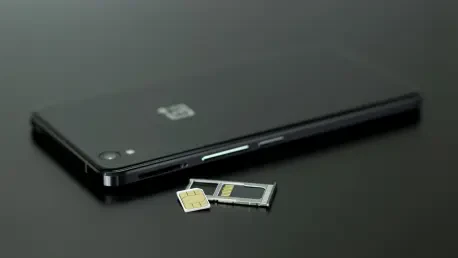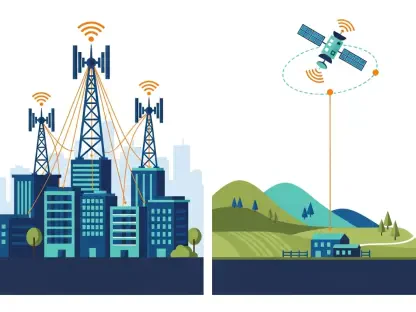The landscape of digital connectivity is undergoing a transformation, largely driven by the introduction of super SIM cards. In recent years, advances in technology have allowed these cards to go beyond their traditional roles, setting the stage for a new era in mobile communication. As digital realms expand and the Internet of Things (IoT) shapes modern life, the demand for more efficient, flexible, and secure SIM card solutions grows. With super SIM cards positioned to become a central component of connectivity environments worldwide, their potential influence stretches far and wide across various sectors. This article delves into the nuances of the super SIM card market, exploring its growth prospects, segmentations, competitive dynamics, and the factors driving its evolution in the current technological landscape.
Market Dynamics and Growth Projections
Expected Market Expansion and Valuation
The global super SIM cards market is witnessing remarkable growth, projected to expand from a valuation of USD 42.32 billion in 2024 to an estimated USD 100.1 billion by 2032. This growth trajectory, marked by a robust compound annual growth rate (CAGR) of approximately 11.37%, highlights the increasing integration of digital technologies into daily life. The critical factors driving this expansion include the demand for high-speed internet connectivity and the rise in IoT device adoption. As the IoT ecosystem grows, super SIM cards provide the necessary connectivity solutions, enhancing device communication and interaction.
The adoption of 5G technology is another significant driver, as it demands advanced SIM card capabilities to manage the increased data flow and connectivity needs. Super SIM cards cater to these demands with features such as enhanced data processing and seamless network switching. As a result, they are instrumental in supporting next-generation networks, ensuring efficient communication channels. Moreover, the diverse applications of super SIM cards across sectors such as telecommunications, automotive, consumer electronics, logistics, healthcare, and industrial automation further propel the market forward. In these areas, super SIMs are crucial for enabling connected technology and providing flexible solutions to meet varying user needs, thereby reinforcing their essential role in the digital era.
Segmentation of the Super SIM Cards Market
The segmentation of the super SIM cards market plays a pivotal role in defining its scope and potential application areas. Segmentation occurs across type, end-user, deployment mode, and device compatibility. In terms of type, the market includes embedded SIMs (eSIMs), removable SIMs, and integrated SIMs. eSIMs are particularly notable for their remote programmability and small form factor, which are ideal for IoT applications where space and accessibility are limited.
End-user segmentation spans several verticals, including telecommunications, automotive, consumer electronics, and logistics. In telecommunications, super SIM cards enable enhanced mobile services and network flexibility for users. In the automotive industry, they facilitate connected car technologies, while in logistics and consumer electronics, such cards ensure the smooth operation of devices with minimal interruption. The deployment mode also segments the market into prepaid and postpaid options, catering to a wider range of user preferences and business models. Furthermore, device compatibility impacts adoption rates, focusing on smartphones, wearables, and industrial equipment which rely on super SIM card functionalities to meet increasing connectivity demands.
Competition and Innovation in the Super SIM Cards Market
Key Players and Their Strategies
The competitive terrain of the super SIM cards market involves a diverse array of industry players. Significant names include telecommunications equipment providers, semiconductor manufacturers, mobile operators, and secure technology firms. These key players drive innovation, propelling market growth and crafting the next generation of SIM solutions. Their efforts center on developing highly secure and programmable SIM cards that adhere to global standards for mobile connectivity and cybersecurity, facilitating over-the-air provisioning and network flexibility.
Research and development investment is a cornerstone strategy employed by these entities, aiming to push the boundaries of SIM functionality. This includes the integration of advanced features to support 5G networks, enable AI-driven capabilities, and ensure interoperability across multiple network operators. Strategic partnerships emerge as vital components within this ecosystem. Telecom companies and technology firms are increasingly pursuing collaborations to craft innovative business models, like SIM-as-a-service and integrated connectivity platforms, broadening market opportunities. Through such alliances, both established multinationals and up-and-coming innovators heighten the pace of technological advancement within the super SIM cards market.
Emerging Technologies and Security Enhancements
Recent advancements in SIM card technology have focused on embedding enhanced security features to safeguard against cybersecurity threats. Super SIM cards are now being equipped with biometric authentication, blockchain support, and end-to-end encryption to protect sensitive information and user identities. AI and machine learning technologies are also being leveraged to offer intelligent device management and predictive maintenance, significantly increasing operational efficiencies. These developments carry implications for both consumer and business uses, offering robust solutions for managing vast network environments.
A prominent emerging trend is the rollout of remote SIM provisioning solutions. This development allows users to switch between operators or plans without the physical exchange of SIM cards, elevating user convenience and reducing operational burdens for service providers. The convergence of telecom operators with cloud service providers supports the emergence of integrated connectivity solutions, vital for enterprises and smart city implementations. As companies align products with evolving compliance standards and ethical data practices, adhering to regulatory demands also becomes crucial. Promoting interoperability and consumer rights is essential as the market continues to develop alongside rapid technological advancements.
Factors Shaping Market Dynamics
Driving Forces and Growth Opportunities
The demand for secure and scalable mobile communication solutions continues to drive the super SIM cards market. This demand is partly fueled by the global deployment of 5G networks, which require super SIMs capable of handling increased data volume, faster speeds, and more complex user profiles. The rise of IoT across various sectors, including healthcare, transportation, and manufacturing, creates further demand for SIMs with extended capabilities such as real-time data analytics and remote device management.
Challenges that could impede market growth include concerns surrounding data privacy, regulatory complexities, and high integration costs. The competitive nature of the industry necessitates addressing these challenges through innovation and strategic planning. Nonetheless, growth opportunities abound, particularly with the increasing popularity of digital wallets, mobile banking, and contactless services. These applications open new use scenarios for super SIM cards, creating avenues for expansion into consumer and industrial markets. The trend towards miniaturized, secure, and efficient connectivity solutions aligns with overarching technological advancements, offering ample room for development and adoption.
Regional Insights and Market Variability
The super SIM cards market’s regional dynamics reveal varied growth patterns influenced by several factors, including technological maturity and regulatory frameworks. In North America, the market benefits from high smartphone penetration, advanced telecom infrastructure, and strong 5G technology uptake. There’s also a heightened demand for secure mobile identity solutions and enterprise mobility, pushing innovation within SIM card technologies.
Europe places significant emphasis on data security and digital transformation while encouraging innovation through robust regulatory frameworks. The focus on cross-border connectivity solutions illustrates the region’s commitment to enhancing communication networks. Meanwhile, the Asia-Pacific region, home to major technological giants like China, India, Japan, and South Korea, experiences rapid urbanization and aggressive 5G rollout, fueling demand for advanced SIM cards. Latin America and the Middle East & Africa reflect gradual adoption, supported by telecom infrastructure investments and raised awareness around super SIM technology’s substantial advantages.
Looking Ahead: Transformative Impacts of Super SIM Cards
As the technological landscape continues to evolve, super SIM cards are set to become integral components of the digital connectivity ecosystem. By offering enhanced capabilities, greater flexibility, and improved security across numerous applications, these advanced SIM cards are revolutionizing how devices interact within the digital sphere. Market growth and transformation are poised to continue as stakeholders invest resources into meeting the need for smarter and more efficient SIM card solutions.
The vibrant competition and collaboration among industry giants and emerging companies are set to usher in an era of unprecedented connectivity solutions. Regionally and globally, the market’s potential will undoubtedly manifest in innovative offerings that match rapidly changing user demands. Companies that strategically leverage technological advances and secure partnerships are likely to capture diverse opportunities within this dynamic and promising market.









